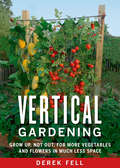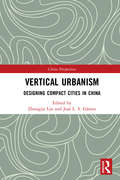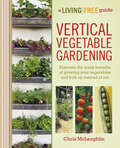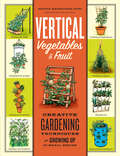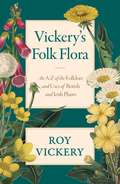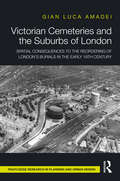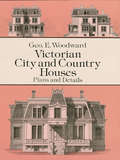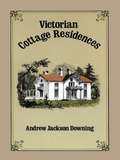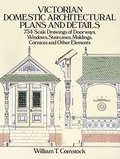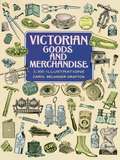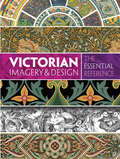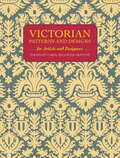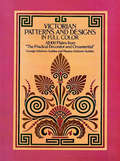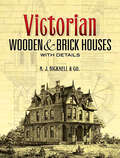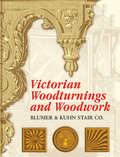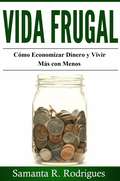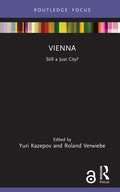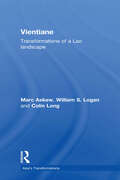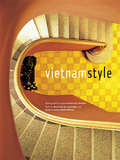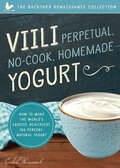- Table View
- List View
Vertical Gardening: Grow Up, Not Out, for More Vegetables and Flowers in Much Less Space
by Derek FellThe biggest mistake gardeners make each season is starting out too big and then quickly realizing their large plot requires too much weeding, watering, and backbreaking labor. Vertical gardening guarantees a better outcome from the day the trowel hits the soil—by shrinking the amount of "floor" space needed and focusing on climbing plants that are less prone to insects, diseases, and animal pests.Notable author and gardener Derek Fell has tried and tested thousands of varieties of vegetables, flowers, and fruits and recommends the best plants for space-saving vertical gardening. His grow-up, grow-down system also shows which ground-level plants make good companions underneath and alongside climbing plants. Best of all, many of Fell's greatest climbers and mutually beneficial plants are available in seed packets in every local garden center.With a mix of DIY and commercially available string supports, trellises, pergolas, raised beds, skyscraper gardens, and topsy-turvy planters, the vertical garden system reduces work, increases yields, makes harvesting easier, and can be practiced in spaces as small as a container or a one-by-four-foot strip. Vertical Gardening features 100 color photos of the author's own vertical methods and showcases beautiful, troublefree perennials, shrubs, vegetables, annuals, and fruit perfect for this new, rewarding way to garden.
Vertical Urbanism: Designing Compact Cities in China (China Perspectives)
by Zhongjie Lin José L. GámezStudies of compact cities have evolved along with the rising awareness of climate change and sustainable development. Relevant debates, however, reveal that the prevailing definitions and practices of compact cities are tied primarily to traditional Western urban forms. This book reinterprets "compact city", and develops a ground-breaking discourse of "Vertical Urbanism", a concept that has never been critically articulated. It emphasizes "Vertical Urbanism" as a dynamic design strategy instead of a static form, distinguishing it from the stereotyped concept of "vertical city" or "towers in the park" dominant in China and elsewhere, and suggests its adaptability to different geographic and cultural contexts. Using Chinese cities as laboratories of investigation, this book explores the design, ecological, and sociocultural dimensions of building compact cities, and addresses important global urban issues through localized design solutions, such as the relationship between density and vitality, the integration of horizontal and vertical dimensions of design, and the ecological and social adaptability of combinatory mega-forms. In addition, through discussions with scholars from the United States, China, and Japan, this book provides an insight into the theoretical debates surrounding "compact city" and "Vertical Urbanism" in the global context. Scholars and students in architecture and urban planning will be attracted by this book. Also, it will appeal to readers with an interest in urban development and Asian studies.
Vertical Vegetable Gardening: Discover the Many Benefits of Growing Your Vegetables and Fruit Up Instead of Ou (A Living Free Guide)
by Chris McLaughlinGrow up, not out! Are you a gardener (or aspiring gardener) who is short on space? Vertical methods and structures for growing plants are an ideal way to maximize your real estate, and they're eye-catching, too.Vertical solutions deliver more yield in fewer square feet, especially perfect for the urban gardener. They're less work, too, so you can forget all-day weeding and watering. Some vegetables, such as tomatoes and pole beans, have been grown vertically for a very long time, but those who need to maximize space can grow almost any type of plant vertically—from melons and squash to carrots, peppers, and pears.Vertical growing isn't just practical, it's beautiful, too! Trellises, terra cotta towers, and hanging planters (to name a few!) transform an outdoor space into a magical garden.Vertical Vegetable Gardening is your thorough guide for growing all types of leafy, root, and other vegetables vertically. Included in the book are: • Creative ideas for structures and containers that will save you space, including DIY projects and repurposing suggestions • Profiles on dozens of plant varieties, including planting, tending, and harvesting instructions • How to make your own garden bed • Soil, seed, and gardening basics • Pest control guidance
Vertical Vegetables & Fruit: Creative Gardening Techniques for Growing Up in Small Spaces
by Rhonda Massingham HartFor gardeners working in confined spaces, Rhonda Massingham Hart presents an ingenious solution for maximizing productivity: grow up! With tepees, trellises, hanging baskets, cages, wall pockets, and multilevel raised beds, you can reap bountiful harvests in even the tiniest growing areas. From kiwis on a clothesline to tomatoes dangling outside a window, Vertical Vegetables & Fruit shows you how to construct and maintain a thriving and abundant garden in whatever small space you have available.
Vickery's Folk Flora: An A-Z of the Folklore and Uses of British and Irish Plants
by Roy VickeryThis book is a dictionary of British (native, naturalised and cultivated) plants and the folklore associated with them. Unlike many plant-lore publications Vickery's Folk Flora tells us what people currently do and believe, rather than what Victorians did and believed. The result is a vivid demonstration that plant folklore in the British Isles is not only surviving but flourishing; adapting and evolving as time goes by, even in urban areas.Each entry includes:- The plant's English and scientific (Latin) name, as well as significant local names.- A brief description of the plant and its distribution, and, in the case of cultivated plants, a history of their introduction to the British Isles- Information on the folklore and traditional uses of the plant, arranged where possible in a sequence starting with general folk beliefs (superstitions), use in traditional customs, use in folk medicine, other uses, and legends concerning individual representatives of the plant.In addition to the major entries there are a number of minor entries for feast days, diseases and other subjects which direct readers to relevant major entries, e.g. St. George's Day, on which red roses are worn; dandelions are gathered; and runner beans are planted.
Victorian Architectural Details: Designs for Over 700 Stairs, Mantels, Doors, Windows, Cornices, Porches, and Other Decorative Elements
by Co. A. J. BicknellHundreds of rare illustrations depict wide range of design alternatives for prospective homeowners and other customers of the late 19th century. While the collection includes elevations and floor plans for a variety of handsome, private residences and commercial structures, the emphasis is on architectural details — from dormer windows to balconies.
Victorian Cemeteries and the Suburbs of London: Spatial Consequences to the Reordering of London’s Burials in the Early 19th Century
by Gian Luca AmadeiThis book explores how Victorian cemeteries were the direct result of the socio-cultural, economic and political context of the city, and were part of a unique transformation process that emerged in London at the time. The book shows how the re-ordering of the city’s burial spaces, along with the principles of health and hygiene, were directly associated with liberal capital investments, which had consequences in the spatial arrangement of London. Victorian cemeteries, in particular, were not only a solution for overcrowded graveyards, they also acted as urban generators in the formation London’s suburbs in the nineteenth century. Beginning with an analysis of the conditions that triggered the introduction of the early Victorian cemeteries in London, this book investigates their spatial arrangement, aesthetics and functions. These developments are illustrated through the study of three private Victorian burial sites: Kensal Green Cemetery, Highgate Cemetery and Brookwood Cemetery. The book is aimed at students and researchers of London history, planning and environment, and Victorian and death culture studies.
Victorian City and Country Houses: Plans and Details
by Geo E. WoodwardThe widespread interest in constructing and restoring Victorian homes makes this a must-have volume for today's builders, homeowners, architects, and preservationists. It offers an abundance of authentic, finely detailed plans and designs for a variety of Victorian residences.Included are 100 front and side elevations, floor plans, and original designs -- all to working scale -- for a block of five city houses, a country house with a French roof, a summer house, various styles of cottages, a tool house, and other buildings. The plates also depict a wealth of details: roof and dormer windows, balustrades, iron fences and gates, finials, crestings, gables, brackets, paneling, mantels, front doors, an oriel window, chimneys, and many other elements.Republished directly from a rare 1877 edition, the book offers a wonderfully authentic look back to the distinctive building styles of the Victorian period. It will not only delight builders and restorationists, but any student or lover of period architecture.
Victorian Cottage Residences
by Andrew Jackson DowningThis incredibly rich, firsthand source for the most popular styles of 19th-century Victorian architecture presents 26 cottage designs -- including Gothic, bracketed, Italianate, "rustic," more -- and 155 illustrations (includes floor plans). The small, inexpensive detached house received one of its earliest popularizations here.
Victorian Domestic Architectural Plans and Details: 734 Scale Drawings of Doorways, Windows, Staircases, Moldings, Cornices, and Other Elements (Dover Architecture)
by William T. ComstockVictorian architecture, with its quirky diversity, eclectic origins, and exuberant ornamentation, continues to exert a strong attraction on today's architects, builders, and homeowners. For those interested in restoring, preserving, or even re-creating Victorian homes, authentic plans and designs are invaluable. This volume, meticulously reproduced from a rare nineteenth-century publication, offers an exceptionally rich pictorial record of actual mid- to late-Victorian designs.Extremely clear and detailed engravings — drawn to scale — present elevations, floor plans, perspectives, and other drawings (in some cases, complete framing plans) for country houses and cottages in a variety of styles: Queen Anne, Eastlake, Elizabethan, Colonial, Jacobean, Southern, Californian, and more. There are even designs for several store and office fronts, with counters, shelving, etc.Supplementing the large number of complete designs are nearly 700 large-scale drawings of virtually every architectural detail, many embodying the unique "gingerbread" that characterizes Victorian buildings. Included are clear, precise renderings of balusters, brackets, dormers, fireplaces, finials, gables, mantels, moldings, newels, porches, rafters, rosettes, staircases, transoms, verandahs, wainscoting, windows, and hundreds of other features.Restorers of old houses, preservationists, students of American architectural history, admirers of Victoriana, and anyone interested in the Victorian Gothic styles that dominated American domestic architecture in the late 1800s will want to have this inexpensive treasury of authentic century-old plans and details.
Victorian Goods and Merchandise: 2,300 Illustrations
by Carol Belanger GraftonThis immensely usable archive of vintage illustrations not only offers a wonderful window on the goods and merchandise of a bygone era, but is an absolute treasure trove of easily reproducible graphic art as well.Some 2,300 cuts culled from such rare nineteenth-century periodicals as The Art Journal, The Illustrated London News, The Scientific American, and The Youth's Companion have been organized in convenient categories: clothes, furniture, kitchenware, toys and games, musical instruments, stationery supplies, domestic accessories, and much more.Among them are detailed and highly reproducible illustrations of fans, corsets, toiletry kits, jewelry, roller skates, a baby carriage, bicycles, baseball gloves, a pencil sharpener, crayons, fountain pen, typewriter, drafting tools, compass, microscope, feather duster, parasol, small table with smoking paraphernalia, high-topped "storm slippers," and hundreds of other objects.
Victorian Imagery and Design: The Essential Reference
by Carol Belanger GraftonRichly detailed, authentic, and engrossing, this compendium draws upon Dover's archives to present a pictorial survey of the Victorian world. Sources include historical periodicals such as Harper's Weekly,The Illustrated London News, and Punch as well as printers' and trade catalogs, architectural graphics, and patterns for fabric and wall decoration by William Morris, Christopher Dresser, and other designers. Hundreds of color and black-and-white images offer glimpses of social history from the great book illustrators of the era as well as ordinary and extraordinary everyday objects, including displays of glassware, furniture, needlework, and stained glass windows from the famous Crystal Palace Exhibition of 1851.Detailed bibliographical information concerning every source - including biographical details of each artist - makes this collection a vital reference tool as well as a stunning compendium of Victorian graphic and pictorial art and illustration. Students of graphic art, typography, and illustration as well as graphic designers and advertising professionals will prize this remarkable resource.
Victorian Patterns and Designs for Artists and Designers (Dover Pictorial Archive)
by Carol Belanger GraftonOver 150 patterns selected from rare 19th-century publications. Florals, foliates, geometrics, and many other motifs ready to add period flavor to almost any project. Indispensable for textile, package and graphic designers, artists, craftspeople, many more.
Victorian Patterns and Designs in Full Color (Dover Pictorial Archive)
by G. A. AudsleyThe last and one of the most important of the great chromolithographic collections of the Victorian era, this magnificent volume first appeared in 1892. Spans a wide spectrum of ornamental styles: Greek moldings and pilaster designs; medieval roof ornamentation, "masonry" patterns; Renaissance coffer and panel ornamentation; Japanese fret bands; and more.
Victorian Wooden and Brick Houses with Details
by Co. A. J. BicknellThis vintage volume offers a treasure trove of floor plans, elevations, and details of residences and public buildings. Artists, architects, and historians alike will find it an endless source of inspiration.Featured buildings include villas, cottages, and farm houses as well as churches, schools, banks, and many other structures. Eighty-one remarkably detailed illustrations capture the elaborate, distinctive beauty of Victorian-era cornices, staircases, gables, verandas, doors, dormers, and other architectural elements. In addition, a fascinating "Specifications" section highlights construction guidelines for masons, bricklayers, and carpenters.
Victorian Woodturnings and Woodwork (Dover Architecture)
by Blumer Kuhn Stair Co.Reproduced from a rare original, this 1893 catalog offers nearly 800 detailed and authentic illustrations of superior-quality woodturnings and woodwork. In addition to its conventional examples, it features varied and unusual models of the Victorian style, including stairs, stair railings and balusters, and newel posts; mantels; turned porch and veranda work; gables and window hoods; ventilators; rosettes and other wooden ornaments; and moldings and interior finish.An excellent guide for woodturners and cabinetmakers, this volume also provides an inspiring and instructive resource for architects, preservationists, designers, and students of Victoriana.
Victory Gardens for Bees: A DIY Guide to Saving the Bees
by Lori WeidenhammerWho knew modern civilization may be brought down, not by plagues or war, but by bees? Or, more correctly, by no bees? This book investigates the growing problem of bee mortality and offers practical measures we can all take to help. In ecological terms, bees play a critical role in the survival of many plant communities and continuation of life on this planet. No pollination, no seeds. No seeds, no future.Now that bees are facing unprecedented levels of die-off caused by a toxic mixture of environmental stresses, a community-based effort is needed to make gardens, fields and landscapes healthy sanctuaries for bees. Just as citizens banded together to produce Victory Gardens to offset the perilous food shortages of World Wars I and II, now a similarly vital level of collective effort is needed to make our gardens into lifesaving shelters for these essential creatures.Planning a bee-friendly space can provide a beautiful and bountiful selection of edible crops, native plants and fragrant ornamentals, as well as herbs that have medicinal properties for both pollinators and people. With the help of ten inspiring garden plans and planting guides, Weidenhammer shows how bee-friendly plants can be used in creative combinations for plots and pots of all sizes, and are easily grown by novices and seasoned gardeners alike. In the spirit of the history-making Victory Gardens, readers will learn how to pack optimum benefits into a limited space for the survival of hive and home, and backyard beekeepers will learn great planting strategies for making sure their honeybees are healthy and have ample food to overwinter.Victory Gardens for Bees is also buzzing with DIY projects that will provide nesting sites and essential supplies for precious pollinators. With plenty of photographs to help readers identify bees of all stripes, beekeeping tips and other interesting bee-phemera, this book is a must-have for anyone who wants to do their part to save bees.
Vida Frugal: Cómo Economizar Dinero y Vivir Más Con Menos.
by Marcela Gutiérrez Bravo Samanta R. RodriguesExisten muchos consejos sobre economizar dinero, que circulan por ahí. Pueden ser simples, como apagar las luces al salir de una habitación, o consejos menos comunes, como moler la propia harina. En Internet, hay foros en los que, si el lector sabe buscar la información correcta, podrá aprender a canalizar el agua de lluvia para la propia hortaliza o para lavar la ropa. O hacer un inventario de artículos (realmente necesarios) que estén en promoción. Claro, el estilo de vida frugal presupone una mentalidad: usted siempre debe preguntarse si realmente precisa de algo antes de comprarlo. Debe conservar lo que ya posee. Debe administrar sus recursos, su tiempo, su dinero y si energía.
Vienna: Still a Just City? (Built Environment City Studies)
by Yuri KazepovThis book explores and debates the urban transformations that have taken place in Vienna over the past 30 years and their consequences in policy fields such as labour and housing, political and social participation and the environment. Historically, European cities have been characterised by a strong association between social cohesion, quality of life, economic ambition and a robust State. Vienna is an excellent example for that. In more recent years, however, cities were pressured to change policy principles and mechanisms in the context of demographic shifts, post-industrial transformations and welfare recalibration which have led to worsened social conditions in many cities. Each chapter in this volume discusses Vienna’s responses to these pressures in key policy arenas, looking at outcomes from the context-specific local arrangements. Against a theoretical framework debating the European city as a model of inclusion and social justice, authors explore the local capacity to innovate urban policies and to address new social risks, while paying attention to potential trade-offs. The book questions and assesses the city’s resilience using time series and an institutional analysis of four key dimensions that characterise the European city model within the context of post-industrial transition: redistribution, recognition, representation and sustainability. It offers a multiscalar perspective of urban governance through labour, housing, participatory and environmental policies, bringing together different levels and public policy types. Vienna: Still a Just City? is aimed at academics, researchers and policy-makers in urban studies, including urban sociology, ecology, geography and welfare.
Vientiane: Transformations of a Lao landscape (Routledge Studies in Asia's Transformations)
by William Logan Colin Long Marc AskewProviding insights into this neglected Southeast Asian city, this interesting book interprets Vientiane’s landscape - physical as well as imagined - as a reflection of key aspects of Lao geo-political history, the nature of Lao urbanism, and its critical relation to constructions of Lao identity in the contemporary period. It is argued that the patterns of change seen through Vientiane’s past embody the key political and economic processes and transformations impacting on the people of Laos. The Lao urban past has rarely been an object of attention by scholars. Laos, in fact, is continually portrayed as a rural backwater, marginal to the dynamic trends affecting most of the Southeast Asian mainland. In contrast to these persistent and static portrayals of Laos as a tiny landlocked backwater, with no significant urban present or past, the authors aim to document, explain and evaluate the significance of the Lao urban landscape. Focusing on the theme of Vientiane’s ‘marginality’ in its various forms, the book interprets this apparent marginality as an historically-produced phenomenon resulting from geo-politics dating from the pre-colonial period and extending into the post-colonial period. Drawing on a wide range of research materials, Vientiane is the first work of its kind on this ignored city.
Vietnam Style
by Luca Invernizzi Tettoni Bertrand De Hartingh Anna Craven-Smith-MilnesVietnam has long captured the imagination of travelers, both real and armchair. It is an appealing country, filled with natural beauty, tranquil village life and fascinating cities. Vietnam also has an inimitable architectural and interior design style, the product of its rich cultural heritage and the various influences of Chinese, French and other Western colonialism.Vietnam Style is an exploration of the balancing act between traditional vernacular design and architecture and the outside influences of colonialism. The unusual and striking new design styles created by melding these elements are a true cultural kaleidoscope of Vietnam today. Chinese-style shophouses, temples with Indian influences, Thai-style palaces, French Colonial civic and domestic buildings, and the variety of tribal and native wooden houses present in Vietnam Style offer an intimate look into the vibrant, yet virtually unknown world of modern Vietnamese architecture and design.
Viili Perpetual, No-Cook, Homemade Yogurt: How to Make the World’s Easiest, Healthiest, 100-Percent Natural Yogurt (Backyard Renaissance Collection)
by Caleb WarnockViili Perpetual No-Cook Homemade Yogurt is the perfect introductory booklet to viili, a yogurt-like, traditional Finnish dish which never needs to be cooked and is made entirely on the countertop by pouring milk into a starter (the residue of the yogurt you just used). Yogurt making has never been easier!With expert advice from self-sufficiency expert Caleb Warnock, Viili Perpetual No-Cook Homemade Yogurt includes the history of viili; where to get a start; how to use it with pasteurized milk, raw milk, and powdered milk; how to store it; how to keep the yogurt sweet; specific scientific health benefits; and twenty delicious recipes.
Villager Jim's Garden Wildlife
by Villager JimBirds, bees, and a whole host of other flora and fauna that share Villager Jims garden in the tiny Peak District village of Foolow, are featured in this stunning book of photographs. Bobbin Robin is just one of the regular visitors to the garden; she and her friends have a huge social media audience, with tens of thousands of viewers. Open up the book to see the daily goings on of these wildlife friends in some of Jims very best pictures taken in this beautiful setting. They illustrate the close relationship Jim has formed with some of the regular wildlife visitors to his garden. His quirky captions capture the mood and spontaneous character of each individual shot and are an essential element of what makes Villager Jims pictures so special.
Villager Jim's Garden Wildlife
by Villager JimBirds, bees, and a whole host of other flora and fauna that share Villager Jims garden in the tiny Peak District village of Foolow, are featured in this stunning book of photographs. Bobbin Robin is just one of the regular visitors to the garden; she and her friends have a huge social media audience, with tens of thousands of viewers. Open up the book to see the daily goings on of these wildlife friends in some of Jims very best pictures taken in this beautiful setting. They illustrate the close relationship Jim has formed with some of the regular wildlife visitors to his garden. His quirky captions capture the mood and spontaneous character of each individual shot and are an essential element of what makes Villager Jims pictures so special.
